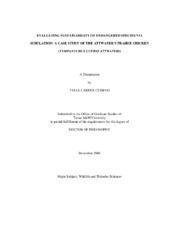| dc.description.abstract | Once abundant in the Texas and Louisiana coastal prairie, currently the Attwater’s Prairie Chicken (Tympanuchus cupido attwateri, APC) is close to extinction. Efforts to increase the size of the remaining populations at the Attwater Prairie Chicken National Wildlife Refuge (APCNWR) and the Galveston Bay Prairie Preserve (GBPP) with releases of captive-reared individuals are part of the APC captive- breeding initiative. However, after a decade of yearly releases, the populations are not reaching viable sizes.
I analyzed post-release survival data of individuals released at the APCNWR from 1996 to 2005. Results suggest that age at release or date of release had little influence on survival of captive-breed APC. At two weeks post-release, survival estimates (SE) were 0.76 (0.03) for females and 0.82 (0.04) for males. Approximately 50% of the females and 33% of the males died within the first 60 days post-release. Survivorship during the breeding season showed that male survival (0.36) was higher than female survival (0.23). Survivorship from the median release date to beginning of the breeding season was 52% for males and 39% for females. Mean female survival was 155 days, while median survival was 94 days. For males, mean survival was 135 days and the median was 81 days. Results from a stochastic simulation model, which was developed based on the survival analysis of APC on the APCNWR, confirmed that releasing individuals closer to the beginning of the breeding season and sex ratio at release had little effect on population growth. Regardless of the number of individuals released annually, population sizes immediately prior to the release dates were only 11–12% of the population sizes immediately after the release dates. At current mortality rates, simulated APC populations could not sustain themselves even if reproductive parameters were increased to the maximum rates reported for APC, or to the maximum rates reported for the closely related Greater prairie chicken. Based on these results, the APC may face extinction within the next decade unless conservation efforts succeed on increasing reproductive success and greatly reducing mortality rates. | en |


